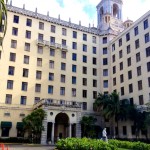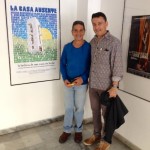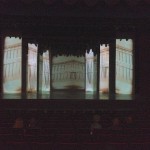La Casa Ausente had its premiere at the 35º Festival del Nuevo Cine Latinoamericano in La Habana Cuba. The festival is regarded by filmmakers, critics and audiences as the most important and prestigious festival in the Latin American world. I felt proud and honored to be in it!
The festival was one of the most inspirational cinematic events I have ever attended. There were 300 films that were selected from a total of 2,400 submissions. There were 33 posters selected from over 300. There were films from all of the countries in South America (except Paraguay), all the Central American countries and many from the Caribbean basin. There were also special series of German, Spanish, Canadian and Italian cinema. There were also pitching sessions by younger Latin American filmmakers that showed what a powerful force the new generation of Latin American filmmakers is. I saw excellent pitches from women directors from Guatemala and México, and from men directors from Argentina, Cuba, and Chile. Their ideas and pitches have nothing to envy American ones, except for their budgets, which were much smaller.
The theme of the festival was a questioning of its title and a reflection of the changing times: ¿nuevo? (new?), ¿cine? (film?) ¿latinoamericano? (Latin American?) Along these lines, every film was introduced by a short presentation of a projectionist burying a can of film in the ground.
The opening was held at the gigantic Karl Marx Theater. The theater reminded me of the large theaters in Times Square back in the 80’s. The opening ceremony began with the sad news of Mandela’s death. After a Cuban modern dance troupe performed an amazingly poetic, expressive modern dance that left me breathless, they screened a documentary recapping the 35 years of the festival and highlighting its founder, Alfredo Guevara’s contributions, who had died earlier this year. Then, they screened the opening film of the festival: Gloria, a Chilean movie about a divorced woman in her late fifties trying to find herself in a new world. Very good. The opening was excellent except for the extremely loud techno music that was played before the beginning. The DJ was deaf, and had bad taste in music.
There were 17 theaters that had six time slots daily, where an average of two films per time slot were shown. This meant an average of 12 films per cinema per day, or 204 films per day.
La Casa Ausente was originally scheduled for Sunday December 8 at the only multiplex cinema in La Habana , the Multi cine Infanta in the Centro Habana section.(see photo)
The festival published the schedule of films one day before they were screened, which was frustrating. They would print a newspaper with a schedule of the films of the day and the following day. I only knew my screening day beforehand because I kept after them via email to tell me in advance.
When we went to the Hotel Nacional, the headquarters of the festival,(see photo) the morning of the day before my film was to be shown, I found out that all the films for the next day, December 8, had been canceled because the government had declared it a national mourning day for Nelson Mandela, who had died 3 days before. This created chaos among all of us filmmakers who had announced the screening to friends and locals, and for people who could only attend during the weekend. Many of the festival staff were also surprised and did not know what to say. By the early evening, they had already reassigned the 200 or so films during the remainder 7 days of the festival.
So, La Casa Ausente was rescheduled for Wednesday December 11 in the same theater at the same time. The screening was a success. People loved the film! Many expressed their wish that the things presented in it could be implemented in their country. Others wanted it shown in schools, universities, to government divisions and to ecological organizations. At the request of a group of people who could not attend and who came in late, it was screened a second time on Saturday 14 December. This time it was screened in the Charlot (after Chaplin) screening room in the ICAIC building in el Vedado. (see photo)
During the two sessions of questions and answers after the documentary, many people gave me tips, encouragement, criticism, compliments and ideas that can extend the reach of the documentary at many levels worldwide. I learned a great deal from their comments and the experience helped me sharpen the focus of the niches where the film could really thrive and get wider audiences.
The poster was also admired and praised by critics and graphic artists. The posters were displayed in a very artistic and professional manner like a gallery exhibit. Our poster was hung in a very prominent place and grabbed the attention of many attendees. In fact, after seeing all the competing posters in person, I was even more impressed by Julio’s work. It really stood out for its tropical colors, its clever design, its message and the overall composition. (see photos)
What’s next for La Casa Ausente? The release of the DVD, a premier in Puerto Rico and other film festivals that are in the pipeline for 2014.
Enjoy the photos and a video excerpt of an interview I did for Cuban TV (recorded by Petra with an iPhone under very windy conditions).











Felicidades :-)
Felicidades!